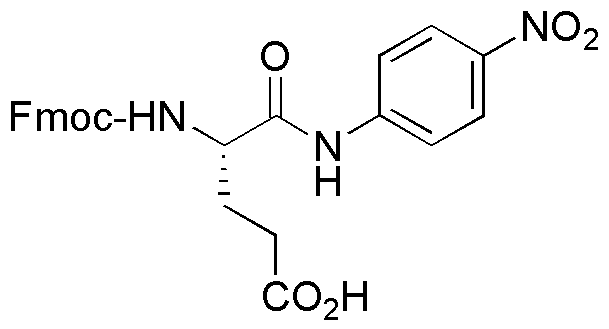Fmoc-L-Glu-pNA is widely utilized in research focused on:
- Peptide Synthesis: This compound serves as a key building block in the synthesis of peptides, allowing researchers to create specific sequences for studying protein functions and interactions.
- Enzyme Activity Assays: It is commonly used in assays to measure the activity of enzymes, particularly those involved in proteolysis, providing valuable insights into metabolic processes.
- Drug Development: In pharmaceutical research, it aids in the design of peptide-based drugs, enhancing the efficacy and specificity of therapeutic agents.
- Bioconjugation: The compound facilitates the conjugation of peptides to other molecules, such as drugs or imaging agents, improving targeted delivery in biomedical applications.
- Fluorescent Labeling: Fmoc-L-Glu-pNA can be used in fluorescent labeling techniques, enabling visualization of proteins in various biological studies, which is crucial for understanding cellular mechanisms.
General Information
Properties
Safety and Regulations
Applications
Fmoc-L-Glu-pNA is widely utilized in research focused on:
- Peptide Synthesis: This compound serves as a key building block in the synthesis of peptides, allowing researchers to create specific sequences for studying protein functions and interactions.
- Enzyme Activity Assays: It is commonly used in assays to measure the activity of enzymes, particularly those involved in proteolysis, providing valuable insights into metabolic processes.
- Drug Development: In pharmaceutical research, it aids in the design of peptide-based drugs, enhancing the efficacy and specificity of therapeutic agents.
- Bioconjugation: The compound facilitates the conjugation of peptides to other molecules, such as drugs or imaging agents, improving targeted delivery in biomedical applications.
- Fluorescent Labeling: Fmoc-L-Glu-pNA can be used in fluorescent labeling techniques, enabling visualization of proteins in various biological studies, which is crucial for understanding cellular mechanisms.
Documents
Safety Data Sheets (SDS)
The SDS provides comprehensive safety information on handling, storage, and disposal of the product.
Product Specification (PS)
The PS provides a comprehensive breakdown of the product’s properties, including chemical composition, physical state, purity, and storage requirements. It also details acceptable quality ranges and the product's intended applications.
Certificates of Analysis (COA)
Search for Certificates of Analysis (COA) by entering the products Lot Number. Lot and Batch Numbers can be found on a product’s label following the words ‘Lot’ or ‘Batch’.
Numéro de catalogue
Numéro de lot/série
Certificates Of Origin (COO)
This COO confirms the country where the product was manufactured, and also details the materials and components used in it and whether it is derived from natural, synthetic, or other specific sources. This certificate may be required for customs, trade, and regulatory compliance.
Numéro de catalogue
Numéro de lot/série
Safety Data Sheets (SDS)
The SDS provides comprehensive safety information on handling, storage, and disposal of the product.
DownloadProduct Specification (PS)
The PS provides a comprehensive breakdown of the product’s properties, including chemical composition, physical state, purity, and storage requirements. It also details acceptable quality ranges and the product's intended applications.
DownloadCertificates of Analysis (COA)
Search for Certificates of Analysis (COA) by entering the products Lot Number. Lot and Batch Numbers can be found on a product’s label following the words ‘Lot’ or ‘Batch’.
Numéro de catalogue
Numéro de lot/série
Certificates Of Origin (COO)
This COO confirms the country where the product was manufactured, and also details the materials and components used in it and whether it is derived from natural, synthetic, or other specific sources. This certificate may be required for customs, trade, and regulatory compliance.


